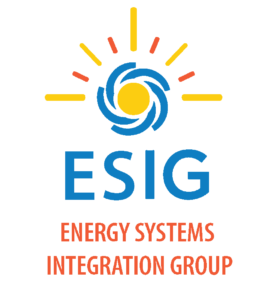The electric power industry is in the midst of a significant transition from a predominantly centralized and fossil fuel-based system to one that is increasingly decarbonized, digital, and distributed. Notably, distributed energy resources (DERs) are expected to grow very rapidly in the near and medium term. According to a National Renewable Energy Laboratory (NREL) November 2021 study of changes from economy-wide electrification, distributed solar is expected to double from 2022 levels by 2030. Perhaps most impactfully, electric vehicles (EVs) could constitute as much as 76% of vehicle miles traveled by 2050. The Edison Electric Institute estimates that more than 100,000 EV fast charging ports will be needed to support the nearly 22 million EVs projected to be on U.S. roads in 2030. Millions of these “rolling DERs” can provide grid management services that grid operators and electric utilities value, including helping to smooth energy demand, providing power to the grid, and regulating voltage and frequency.
Demand Flexibility: A Key Enabler of a Dynamic, Decarbonized Energy System

Matthew McDonnell
Today, electricity generation mostly follows customer demand. Utilities and grid operators dispatch power plants when customers choose to turn on their lights and appliances. But in a high-renewable, high-DER electric grid, this one-way relationship between supply and demand is no longer fit-for-purpose. Having served nearly a half-decade at the Hawaii Public Utilities Commission, I’ve seen firsthand that a much more coordinated, dynamic, and iterative interaction between electricity supply and demand is required as we increasingly integrate abundant and low-cost renewables onto the grid, electrify transportation, and decarbonize buildings.
As of 2020, 35% of Hawaiian Electric’s electricity sales came from renewable sources. Moreover, more than 30% of single-family homes had installed rooftop solar, and per-customer adoption of EVs exceeded that of any state other than California.
Such a dramatic transition presents both challenges and opportunities for the entire industry. In response, the Hawaii Public Utilities Commission and Hawaiian Electric worked with purpose to unlock the range of electricity system benefits that DER can provide—updating interconnection rules to embrace advanced inverter functionality and support local voltage needs; evolving traditional planning processes to optimize transmission, distribution, and generation across the system; modernizing rate design to reflect the time-differentiated needs of the grid; and demonstrating the ability of EV charging infrastructure to provide core grid services, such as fast frequency response.
As the waves of variable renewable energy and DER move beyond Hawaii’s shores to the broader U.S., utilities and regulators alike are recognizing the critical role that DERs must play in a well-managed and cost-effective clean electricity transition. Without closer coordination between electric distribution and transmission systems, the U.S. electric grid risks being materially overbuilt and increasingly challenging to operate, leading to higher costs, delivering lower reliability, and increasing the likelihood of stranded ratepayer investments.
Closer coordination means that distribution and transmission systems will need to be planned and operated as an interactive, integrated whole, with power flows to and from distribution systems that shift as DERs respond to changing conditions in wholesale markets, and wholesale markets and operations, in turn, respond to changes in load and DER in distribution systems. Moving toward this more interactive grid will require better integration of DERs into markets and operations at both the bulk power and distribution system level. Regulatory frameworks and market rules to do so remain, however, in the early stages.
DER Integration: FERC Order 2222 and Beyond
To illustrate the scale of opportunity presented by DERs, we need to look no further than the ascendent EV market. In 2021, grid-tied (large-scale) battery storage in the U.S. totaled roughly 5.4 GWh. By comparison, there is approximately 138 GWh in battery capacity within the roughly 2.3 million EVs sold to date in the U.S. (assuming average battery capacity of 60 kWh). This untapped EV battery capacity will likely increase tenfold to match the 22 million EVs expected to be on roads by 2030.
The Federal Energy Regulatory Commission (FERC) has recognized the importance of harnessing DER value for the benefit of all customers through Order 2222 (released September 202 0), which supports initial steps toward better integration of DERs into wholesale markets. Each independent system operator or regional transmission organization (ISO/RTO) must develop a compliance plan to cover a broad array of requirements, including DER interconnection; aggregation composition and size; information and data sharing; and coordination among the RTO/ISO, distribution utility, DER aggregator, and state and local regulatory authorities. Nonetheless, critical activities necessary to enable effective DER integration remain—with distribution utilities and state regulators needing to play an active role in setting the proper conditions for success. Few electric distribution utilities have developed interconnection procedures that are consistent with Order 2222 or rigorous processes for reviewing DER aggregations, communicating outages, and overriding ISO scheduling and dispatch. State regulatory commissions will need to ensure that utilities develop procedures and processes that are efficient, fair, transparent, and non-discriminatory.
Nearer-term implementation issues around FERC Order 2222 are but a small subset of the challenges and gaps for better integrating DERs into the electric power system more broadly. From the perspective of a future electric grid state where the distribution and transmission systems are more interactive and integrated, in which DERs may be providing distribution-level and transmission-level services, the gaps to DER market integration extend beyond those required for nearer-term Order 2222 implementation.
Broader gaps to DER integration can be broken down into the following categories of activities:
- Distribution and transmission planning
- Distribution interconnection
- Communications and data sharing
- Distribution operations
- Wholesale market design
- Market regulation
- Utility regulation and business models
Addressing Gaps and Advancing a National Initiative on DER Integration
To help illuminate viable pathways toward an integrated, high-DER electric system, ESIG established a DER integration task force made up of a diverse set of industry experts and directed the development of a three-report series that were informed by robust stakeholder dialogue. In the first report, my co-authors and I have identified strategies to help state regulators, utilities, and ISOs navigate key next steps:
- START WITH MINOR CHANGES. Begin from an assumption that relatively minor changes in distribution planning, distribution operations, and utility investments in monitoring and controls necessary to support them will be needed for near-term compliance with Order 2222.
- LEVERAGE EXISTING DATA. Leverage data from DER registration and interconnection in DER aggregation reviews to minimize the need for additional study during reviews; in most cases, DER aggregation review should not require redoing interconnection studies.
- USE EXISTING PROCESSES FOR COMMUNICATIONS AND DATA-SHARING. Rather than create new processes and additional complexity, make use of existing protocols and processes for communications and data-sharing among utilities, aggregators, and ISOs/RTOs (utilities, DER aggregators, ISOs/RTOs).
- DEVELOP WORKABLE APPROACHES TO UTILITY OVERRIDES. Focus initially on developing workable approaches to utility overrides, based on a foundation of efficient communication between utilities and aggregators, with terms and conditions that are clearly articulated in interconnection and aggregator agreements and can evolve over time.
- PRIORITIZE ADOPTION AND IMPLEMENTATION OF IEEE 1547-2018. Voltage support provided through compliance with interconnection standards may reduce the need for overrides and distribution upgrades.
- PARTICIPATE IN NATIONAL, INDUSTRY-WIDE DIALOGUE. Begin or be a part of broad conversations on forward-looking issues where solutions can be accelerated through joint, creative problem-solving and the development of a set of nation-wide best practices.
We recognize that resolving the myriad DER integration issues will not be easy. But given the scale of the opportunity and the imperative to enable an affordable and consumer-centric energy transition, we need to begin working collaboratively across industry to expeditiously develop standardized solution templates for utilities and regulators to implement against. To that end, a national-level initiative in the U.S., informed by lessons learned from similar initiatives in Australia and the United Kingdom, could offer a forum for dialogue on the most critical of these issues. This kind of initiative could enable greater national consensus on where key challenges lie, forge some degree of standardization in terminology and solutions, and lay the market, regulatory, and operational groundwork for cleaner, more interactive, and more integrated electricity systems of the future.
Matthew McDonnell
Managing Director, Strategen

Matt,
As usual very sage. I also believe that Microgrids, energy storage(flexible generation) at DG substations could provide Demand Management…add cyber detect- protect- Island, FAST EV Charging, and wireless deferral control of major equipment loads on that circuit. Could use mature utility scale solar + Storage PPA to fund….locate solar within, close proximity to DG, minimize transmission cost, kwh loss. Would also help our water issues,, accelerate retirement of ff plants….another 15 years of emissions
Am trying to get COT TEP to do that….contact me